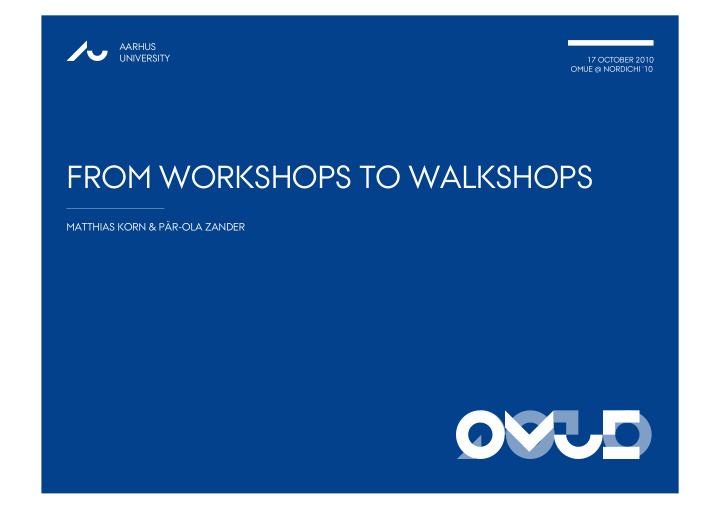



AARHUS UNIVERSITY 17 OCTOBER 2010 OMUE @ NORDICHI ‘10 FROM WORKSHOPS TO WALKSHOPS MATTHIAS KORN & PÄR-OLA ZANDER omue 2010 1
AARHUS UNIVERSITY FROM WORKSHOPS TO WALKSHOPS 17 OCTOBER 2010 MATTHIAS KORN OMUE @ NORDICHI ‘10 AARHUS UNIVERSITY IN SITU CO-DESIGN AND EVALUATION › Observing use “in the wild” › Observing sense-making processes of the users › More severe di ff erences with situated mobile use › Walkshops enable the study of context paired with the micro-processes of sense-making Walking as a tool for thinking & closer relation to the context of use Complementary method for early on in the design process 2
AARHUS UNIVERSITY FROM WORKSHOPS TO WALKSHOPS 17 OCTOBER 2010 MATTHIAS KORN OMUE @ NORDICHI ‘10 AARHUS UNIVERSITY AGENDA › Motivation › Setting and Prototype › Issues with Traditional PD Activities › Walkshops: Theory and Practice › Conclusion 3
AARHUS UNIVERSITY FROM WORKSHOPS TO WALKSHOPS 17 OCTOBER 2010 MATTHIAS KORN OMUE @ NORDICHI ‘10 AARHUS UNIVERSITY MOBILE DEMOCRACY › Mobile application to engage citizen participation in municipal planning › Citizens can suggest changes to the plan or react to proposed changes › Location-aware notifications › Mobile app to take first steps while in the situation › Desktop interface for reflection and deeper engagement at home 4
AARHUS UNIVERSITY FROM WORKSHOPS TO WALKSHOPS 17 OCTOBER 2010 MATTHIAS KORN OMUE @ NORDICHI ‘10 AARHUS UNIVERSITY PARTICIPATORY DESIGN PROCESS › Involving a municipality, community-based organizations, and individual citizens Activities: Design artifacts: › Moderated group discussions › Scenarios between users and designers › Storyboards › Experience-based workshops › Paper mock-ups › Future workshops › Functional prototypes › Pluralistic & cognitive walkthroughs 5
AARHUS UNIVERSITY FROM WORKSHOPS TO WALKSHOPS 17 OCTOBER 2010 MATTHIAS KORN OMUE @ NORDICHI ‘10 AARHUS UNIVERSITY ISSUES WITH TRADITIONAL PD ACTIVITIES › Limitations to user exploration › Limiting confines of the room › Location-dependant functionality staged › Shortage of objects to interact with › Not a ff ording flexibility in discussions › Formal meeting room atmosphere › Time and stress constraints on the user unrealistic 6
AARHUS UNIVERSITY FROM WORKSHOPS TO WALKSHOPS 17 OCTOBER 2010 MATTHIAS KORN OMUE @ NORDICHI ‘10 AARHUS UNIVERSITY WALKSHOPS › Co-design & evaluation in more realistic and natural settings › while still being able to gain insights into users’ sense-making processes › Walking (as in going for a walk) as a thinking tool that stimulates reflection › Focus on understanding the mediating technology, not the environment it is used in Bringing the evaluation into the context, rather than the user’s context into the evaluation situation 7
AARHUS UNIVERSITY FROM WORKSHOPS TO WALKSHOPS 17 OCTOBER 2010 MATTHIAS KORN OMUE @ NORDICHI ‘10 AARHUS UNIVERSITY “THE RHYTHM OF WALKING GENERATES A RHYTHM OF THINKING” (Solnit 2001 in Anderson 2004, p. 258) 8
AARHUS UNIVERSITY FROM WORKSHOPS TO WALKSHOPS 17 OCTOBER 2010 MATTHIAS KORN OMUE @ NORDICHI ‘10 AARHUS UNIVERSITY WALKSHOP STUDY › 3 walkshops at di ff erent stages › With 3 planners from the municipality: location- dependent notification of topics, topic details, map › With 4 individual citizens: re-design, also create topics (w/ photos), augmented reality view › With 6 planners and others from the municipality: more polished prototype, mood › Integrated into user workshops › 45mins, ca. 1km in a 3-hour workshop › Short briefing and follow-up discussion › Researchers in the roles of facilitators, observers, and partners 9
AARHUS UNIVERSITY FROM WORKSHOPS TO WALKSHOPS 17 OCTOBER 2010 MATTHIAS KORN OMUE @ NORDICHI ‘10 AARHUS UNIVERSITY NEW INSIGHTS AND STRENGTHS › Usability problems previously unidentified (e.g. data input under stress) › How and to what extent the system can be used “in the wild” › Type and quality of content being created › Interacting with real-world objects and issues › Real environments provide more graspable stimuli to fuel users’ imagination › More elaborate discussions and reflections on actual and envisioned use › A ff orded flexible and frequent reconfigurations of usage and discussions situations › Location and other context variables can be incorporated more easily 10
AARHUS UNIVERSITY FROM WORKSHOPS TO WALKSHOPS 17 OCTOBER 2010 MATTHIAS KORN OMUE @ NORDICHI ‘10 AARHUS UNIVERSITY CONCLUSION › Walkshops enable the study of context paired with the micro-processes of sense-making › Walking as a tool for thinking & closer relation to the context of use Advantages: Limitations: › informal, more realistic stress › stage in the design process, constraints, flexible reconfiguration, functionality, accessibility, design exploration, real stimuli and real- artifacts that can be used, realism, world objects to interact with, user scalability engagement Complementary method to other participator design activities 11
AARHUS UNIVERSITY 17 OCTOBER 2010 OMUE @ NORDICHI ‘10 FROM WORKSHOPS TO WALKSHOPS MATTHIAS KORN 1 & PÄR-OLA ZANDER 2 1 AARHUS UNIVERSITY 2 AALBORG UNIVERSITY MKORN@CS.AU.DK POZ@HUM.AAU.DK COLLABORATORS: MORTEN BOHØJ, NIKOLAJ GANDRUP BORCHORST & SUSANNE BØDKER Thank You!
Recommend
More recommend